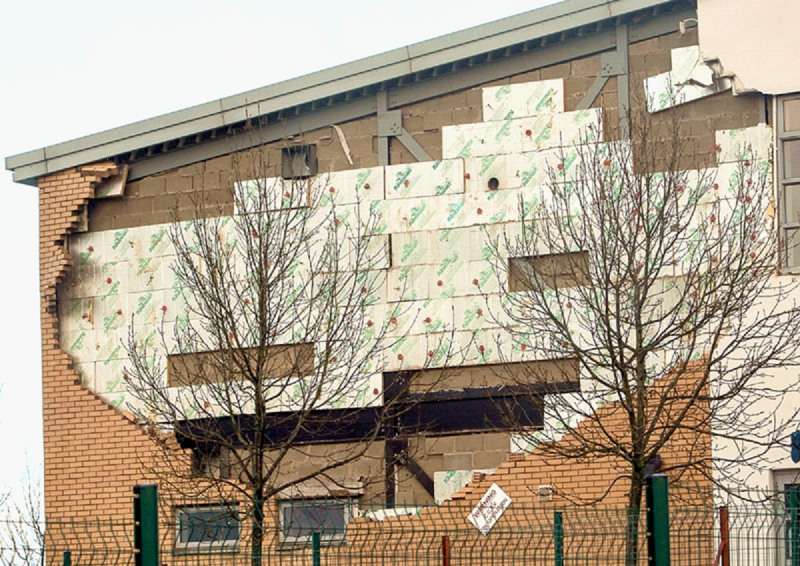Building sector failing on supervision
Senior ICE Scotland members discuss the 2017 inquiry into Scottish building failures which showed the need for more supervision on all sites.
Contents |
[edit] Introduction
In January 2016, storm Gertrude caused a substantial section of the upper level of an external brickwork facade of Oxgangs School in Edinburgh to collapse onto a pathway below. Fortunately it was early in the morning and the school was deserted.
The school and 15 others were built under a public–private partnership (PPP) project for the City of Edinburgh Council and were completed by 2005. Following inspection similar problems were evident over all school buildings in the PPP scheme so all were closed and repaired during 2016.
The council commissioned an inquiry led by John Cole (2017). This found a catalogue of construction failures including inadequate tie embedment, varying cavity width, poor wall verticality, missing or inadequate head restraint and missing bed reinforcement issues. Construction had been carried out under a quality assurance regime but there was almost no traditional site inspection undertaken. Lack of as-built records were a further issue.
[edit] Lack of supervision
The Scottish government sought industry comment on the inquiry report and ICE Scotland’s response was taken forward by its public voice committee. Subsequently written evidence was also given to the education and skills committee of the Scottish parliament.
ICE Scotland found little to disagree with in the inquiry report. It noted that on building projects there are typically multi-disciplinary involvements which can lead to challenges when considering technical supervision, which is sometimes on a visiting basis. In civil engineering this is usually carried out on a full-time basis – and arguably is necessary for managing the contractual process.
Experience suggests that supervision, inspection and testing has diminished over the years for financial reasons. Building is a production industry but while other production industries have focused on quality control the building industry typically produces complex and mostly unique products. Basic quality checking has been engineered out in many cases.
[edit] Risk analysis approach
ICE Scotland considered that in all likelihood the problems identified in Scotland exist elsewhere irrespective of the procurement method. Clients therefore need to adopt appropriate supervision methodologies based on a risk analysis approach – certainly they should not delegate supervision to their contractors.
PPP, design-build-finance-operate, and design-build contract forms can be adapted to ensure that mandatory supervision is provided in a transparent way. Construction records are an essential part of project completion and should be required prior to facility use.
In July 2017, the Scottish government issued interim guidance for site inspection and assurance for public sector clients. Construction Scotland was tasked to advise the government on steps being taken and ICE Scotland is playing its part.
Issues being developed include training and verification of brickwork apprentices, technical guidance detailing for masonry, best practice in quality assurance systems, continual professional development training in brickwork detailing and design coordination best practice.
[edit] Back to basics
It is perhaps hard to believe that these failures occurred in the early-21st century. Project management, programme management and quality assurance systems all have their place but perhaps the construction industry needs to relearn the basics.
A project needs to be properly designed and the design needs to be appropriately checked. The design needs to be translated into construction and the construction needs to be independently supervised. Design alterations need to be referred to the designer and adequate as-built records need to be produced.
It all sounds very basic – and it is.
This article was originally published here by ICE on 5 June 2018. It was written by Ronnie Hunter, ICE council member for Scotland, and Jim Young, ICE Scotland senior vice chair.
--The Institution of Civil Engineers
[edit] Related articles on Designing Buildings Wiki
Featured articles and news
A change to adoptive architecture
Effects of global weather warming on architectural detailing, material choice and human interaction.
How big is the problem and what can we do to mitigate the effects?
Overheating guidance and tools for building designers
A number of cool guides to help with the heat.
The UK's Modern Industrial Strategy: A 10 year plan
Previous consultation criticism, current key elements and general support with some persisting reservations.
Building Safety Regulator reforms
New roles, new staff and a new fast track service pave the way for a single construction regulator.
Architectural Technologist CPDs and Communications
CIAT CPD… and how you can do it!
Cooling centres and cool spaces
Managing extreme heat in cities by directing the public to places for heat stress relief and water sources.
Winter gardens: A brief history and warm variations
Extending the season with glass in different forms and terms.
Restoring Great Yarmouth's Winter Gardens
Transforming one of the least sustainable constructions imaginable.
Construction Skills Mission Board launch sector drive
Newly formed government and industry collaboration set strategy for recruiting an additional 100,000 construction workers a year.
New Architects Code comes into effect in September 2025
ARB Architects Code of Conduct and Practice available with ongoing consultation regarding guidance.
Welsh Skills Body (Medr) launches ambitious plan
The new skills body brings together funding and regulation of tertiary education and research for the devolved nation.
Paul Gandy FCIOB announced as next CIOB President
Former Tilbury Douglas CEO takes helm.
UK Infrastructure: A 10 Year Strategy. In brief with reactions
With the National Infrastructure and Service Transformation Authority (NISTA).
Ebenezer Howard: inventor of the garden city. Book review.
Airtightness Topic Guide BSRIA TG 27/2025
Explaining the basics of airtightness, what it is, why it's important, when it's required and how it's carried out.























